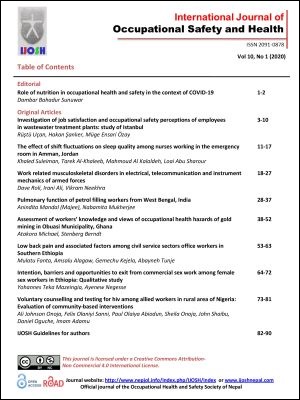The Effect of Shift Fluctuations on Sleep Quality among Nurses Working in the Emergency Room in Amman, Jordan
DOI:
https://doi.org/10.3126/ijosh.v10i1.29877Keywords:
Emergency room, Nurses, Shift fluctuation, Sleep qualityAbstract
Introduction: Sleep Quality disturbances are common among nurses especially those working in stressful situations such as emergency room. Additionally, sleep quality disturbances were found to interfere with nurses’ quality of life and work performance. No studies have found the effect of fluctuated shifts on sleep quality among nurses.
Objectives: To examine the impact of shift fluctuations on sleep quality among nurses working in the emergency room.
Methods: A cross-sectional, descriptive design was employed. Five emergency rooms were selected from public and private hospitals located in Amman, Jordan. The selected hospitals were also referral sites with capacity of more than 200 beds. A convenient sample of nurses who had a minimum of six months experience in the emergency room and working on rotating shifts were eligible for participation. Nurses with known chronic respiratory problems and sleep apnea were excluded. A self-administered questionnaire including a demographic and work-related questions, and the Arabic version of the Pittsburgh Sleep Quality Index were provided. Shift fluctuations were clustered based on interchanging between morning, evening and night shifts.
Results: A total of 179 emergency nurses working in rotating shifts participated in the study. The majority of the nurses were poor sleepers. The study found no significant differences between different shifts interchange and sleep quality. However, interchange between morning and evening shift reported the highest sleep disturbance. Sleep quality was positively correlated with the length of experience, while negatively correlated with the age and the number of monthly shifts. Nurses who declared higher satisfaction and ability to work under pressure revealed better sleep quality.
Conclusion: Emergency room nurses showed poor sleep quality. While there was no specific shift interchange cluster inducing poor sleep quality, some demographical and work-related characteristics indicated their influence on sleep quality.
Downloads
Downloads
Published
How to Cite
Issue
Section
License
This license enables reusers to distribute, remix, adapt, and build upon the material in any medium or format for noncommercial purposes only, and only so long as attribution is given to the creator.





